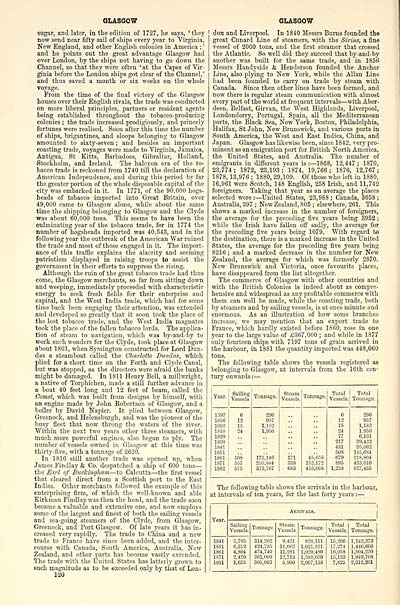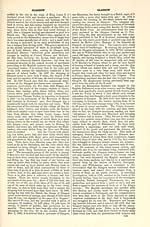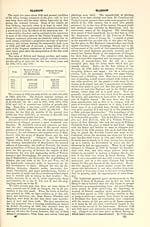Ordnance gazetteer of Scotland > Volume 3
(190) Page 120
Download files
Complete book:
Individual page:
Thumbnail gallery: Grid view | List view

GLASGOW
sugar, and later, in the edition of 1727, he says, 'they
now send near fifty sail of ships every j'ear to Virginia,
New England, and other English colonies in America ; '
and he points out the great advantage Glasgow had
over London, by the ships not having to go down the
Channel, so that they were often ' at the Capes of Vir-
ginia before the London ships got clear of the Channel,'
and thus saved a month or six weeks on the whole
voyage.
From the time of the final victory of the Glasgow
houses over their English rivals, the trade was conducted
on more liberal principles, partners or resident agents
being established throughout the tobacco-producing
colonies ; the trade increased prodigiously, and princely
fortunes were realised. Soon after this time the number
of ships, brigantines, and sloops belonging to Glasgow
amounted to sixty-seven ; and besides an important
coasting trade, voyages were made to Virginia, Jamaica,
Antigua, St Kitts, Barbadoes, Gibraltar, Holland,
Stockholm, and Ireland. The halcyon era of the to-
bacco trade is reckoned from 1740 tUl the declaration of
American Independence, and during this period by far
the greater portion of the whole disposable capital of the
city was embarked in it. In 1771, of the 90,000 hogs-
heads of tobacco imported into Great Britain, over
49,000 came to Glasgow alone, while about the same
time the shipping belonging to Glasgow and the Clyde
was about 60,000 tons. This seems to have been the
culminating year of the tobacco trade, for in 1774 the
number of hogsheads imported was 40,543, and in the
following year the outbreak of the American War ruined
the trade and most of those engaged in it. The import-
ance of this traffic explains the alacrity and seeming
patriotism displayed in raising troops to assist the
government in their efTorts to suppress the rising.
Although the ruin of the great tobacco trade had thus
come, the Glasgow merchants, so far from sitting down
and weeping, immediately proceeded with characteristic
energy to seek fresh fields for their enterprise and
capital, and the West India trade, which had for some
time back been engaging their attention, was extended
and developed so greatly that it soon took the place of
the lost tobacco trade, and the West India magnates
took the place of the fallen tobacco lords. The applica-
tion of steam to navigation, which was by-and-by to
work such wonders for the Clyde, took place at Glasgow
about 1801, when Symington constructed for Lord Dun-
das a steamboat called the Charlotte Dundas, which
plied for a short time on the Forth and Clyde Canal,
but was stopped, as the directors were afraid the banks
might be damaged. In 1811 Henry Bell, a milhvright,
a native of Torphichen, made a still further advance in
a boat 40 feet long and 12 feet of beam, called the
Comet, which was built from designs by himself, with
an engine made by John Robertson of Glasgow, and a
boiler by David Napier. It plied between Glasgow,
Greenock, and Helensburgh, and was the pioneer of the
busy fleet that now throng the waters of the river.
Within the next two years other three steamers, with
much more powerful engines, also began to ply. The
number of vessels owned in Glasgow at this time was
thirty-five, with a tonnage of 2620.
In 1816 still another ti'ade was opened up, when
James Findlay & Co. despatched a ship of 600 tons —
t\)& Earl of Buckingliam — to Calcutta — the first vessel
that cleared direct from a Scottish port to the East
Indies. Other merchants followed the example of this
enterprising firm, of which the well-known and able
Kirkman Findlay was then the head, and the trade soon
became a valuable and extensive one, and now employs
some of the largest and finest of both the sailing vessels
and sea-going steamers of the Clyde, from Glasgow,
Greenock, and Port Glasgow. Of late years it has in-
creased very rapidly. The trade to China and a new
trade to France have since been added, and the inter-
course with Canada, South America, Australia, New
Zealand, and other parts has become vastly extended.
The trade with the United States has latterly grown to
such magnitude as to be exceeded only by that of Lon-
120
GLASGOW
I don and Liverpool. In 1840 Messrs Burns founded the
great Cnnard Line of steamers, \AW\ the Sirius, a fine
vessel of 2000 tons, and the first steamer that crossed
the Atlantic. So well did they succeed that by-and-by
another was built for the same trade, and in 1856
Messrs Handyside & Henderson founded the Anchor
Line, also plying to New York, while the Allan Line
had been founded to carry on trade by steam with
Canada. Since then other lines have been formed, and
now there is regular steam communication with almost
every part of the world at frequent intervals — with Aber-
deen, Belfast, Girvan, the West Highlands, Liverpool,
Londonderry, Portugal, Spain, all the Mediterranean
ports, the Black Sea, New York, Boston, Philadelphia,
Halifax, St John, New Brunswick, and various ports in
South America, the West and East Indies, China, and
Japan. Glasgow has likewise been, since 1842, very pro-
minent as an emigi-ation port for British North America,
the United States, and Australia. The number of
emigrants in different vears is : — 1868, 12,447 ; 1870,
23,774 ; 1872, 23,193 ;' 1874, 19,766 ; 1876, 12,767 ;
1878, 13,976 ; 1880, 29,109. Of those who left in 1880,
16,961 were Scotch, 148 English, 258 Irish, and 11,742
foreigners. Taking that year as an average the places
selected were: — United States, 23,988; Canada, 3658;
Australia, 397 ; New Zealand, 805 ; elsewhere, 261. This
shows a marked increase in the number of foreigners,
the average for the preceding five years being 3952 ;
while the Irish have fallen off sadly, the average for
the preceding five years being 1079. With regard to
the destination, there is a marked increase in the United
States, the average for the preceding five years being
8216 ; and a marked decrease in the number for New
Zealand, the average for which was formerly 2870.
New Brunswick and Victoria, once favourite places,
have disappeared from the list altogether.
The commerce of Glasgow with other countries and
with the British Colonies is indeed about as compre-
hensive and widespread as any profitable commerce with
them can well be made, while the coasting trade, both
by steamers and by sailing vessels, is at once minute and
enormous. As an illustration of how some branches
increase, we may mention that an export trade to
France, which hardly existed before 1860, rose in one
year to the large value of £367,000 ; and while in 1877
only fourteen ships with 7197 tons of grain arrived in
the harbour, in 1881 the quantity imported was 448,060
tons.
The following table shows the vessels registered as
belonging to Glasgow, at intervals from the 16th cen-
tury onwards : —
Tear.
Sailing
Vessels.
Tonnage.
Steam
Vessels.
Tonnage.
Total
Vessels.
Total
Tonnage.
1597
6
296
6
296
1656
12
857
12
957
1692
15
1,182
15
1,182
ISIO
24
1,956
24
1,956
1820
..
77
6,131
1830
217
39,432
1841
431
95,062
1861
508
145,684
1861
608
173,146
171
45
658
679
218,804
1871
557
280,844
338
162
172
895
433,016
1882
675
373,767
6S3
463,668
1,258
527,435
The following table shows the arrivals in the harbour,
at intervals of ten years, for the last forty years : —
Year.
1
Arrivals. j
Sailing
Vessels.
Tonnage.
Steam
Vessels.
Tonnage.
Total
Vessels.
Total
Tonnage.
1841
1851
1861
1871
1831
6,785
6,212
4,804
2 420
1,635
314,262
424,785
474,740
361,009
305,003
9,421
11,062
11,281
12,713
6,990
828,111
1,021,821
1,029,480
1,588,699
2,007,138
15,206
17,274
16,058
16,133
7,626
1,142,373
1,446,606
1,504,220
1,949,708
2,312,201
sugar, and later, in the edition of 1727, he says, 'they
now send near fifty sail of ships every j'ear to Virginia,
New England, and other English colonies in America ; '
and he points out the great advantage Glasgow had
over London, by the ships not having to go down the
Channel, so that they were often ' at the Capes of Vir-
ginia before the London ships got clear of the Channel,'
and thus saved a month or six weeks on the whole
voyage.
From the time of the final victory of the Glasgow
houses over their English rivals, the trade was conducted
on more liberal principles, partners or resident agents
being established throughout the tobacco-producing
colonies ; the trade increased prodigiously, and princely
fortunes were realised. Soon after this time the number
of ships, brigantines, and sloops belonging to Glasgow
amounted to sixty-seven ; and besides an important
coasting trade, voyages were made to Virginia, Jamaica,
Antigua, St Kitts, Barbadoes, Gibraltar, Holland,
Stockholm, and Ireland. The halcyon era of the to-
bacco trade is reckoned from 1740 tUl the declaration of
American Independence, and during this period by far
the greater portion of the whole disposable capital of the
city was embarked in it. In 1771, of the 90,000 hogs-
heads of tobacco imported into Great Britain, over
49,000 came to Glasgow alone, while about the same
time the shipping belonging to Glasgow and the Clyde
was about 60,000 tons. This seems to have been the
culminating year of the tobacco trade, for in 1774 the
number of hogsheads imported was 40,543, and in the
following year the outbreak of the American War ruined
the trade and most of those engaged in it. The import-
ance of this traffic explains the alacrity and seeming
patriotism displayed in raising troops to assist the
government in their efTorts to suppress the rising.
Although the ruin of the great tobacco trade had thus
come, the Glasgow merchants, so far from sitting down
and weeping, immediately proceeded with characteristic
energy to seek fresh fields for their enterprise and
capital, and the West India trade, which had for some
time back been engaging their attention, was extended
and developed so greatly that it soon took the place of
the lost tobacco trade, and the West India magnates
took the place of the fallen tobacco lords. The applica-
tion of steam to navigation, which was by-and-by to
work such wonders for the Clyde, took place at Glasgow
about 1801, when Symington constructed for Lord Dun-
das a steamboat called the Charlotte Dundas, which
plied for a short time on the Forth and Clyde Canal,
but was stopped, as the directors were afraid the banks
might be damaged. In 1811 Henry Bell, a milhvright,
a native of Torphichen, made a still further advance in
a boat 40 feet long and 12 feet of beam, called the
Comet, which was built from designs by himself, with
an engine made by John Robertson of Glasgow, and a
boiler by David Napier. It plied between Glasgow,
Greenock, and Helensburgh, and was the pioneer of the
busy fleet that now throng the waters of the river.
Within the next two years other three steamers, with
much more powerful engines, also began to ply. The
number of vessels owned in Glasgow at this time was
thirty-five, with a tonnage of 2620.
In 1816 still another ti'ade was opened up, when
James Findlay & Co. despatched a ship of 600 tons —
t\)& Earl of Buckingliam — to Calcutta — the first vessel
that cleared direct from a Scottish port to the East
Indies. Other merchants followed the example of this
enterprising firm, of which the well-known and able
Kirkman Findlay was then the head, and the trade soon
became a valuable and extensive one, and now employs
some of the largest and finest of both the sailing vessels
and sea-going steamers of the Clyde, from Glasgow,
Greenock, and Port Glasgow. Of late years it has in-
creased very rapidly. The trade to China and a new
trade to France have since been added, and the inter-
course with Canada, South America, Australia, New
Zealand, and other parts has become vastly extended.
The trade with the United States has latterly grown to
such magnitude as to be exceeded only by that of Lon-
120
GLASGOW
I don and Liverpool. In 1840 Messrs Burns founded the
great Cnnard Line of steamers, \AW\ the Sirius, a fine
vessel of 2000 tons, and the first steamer that crossed
the Atlantic. So well did they succeed that by-and-by
another was built for the same trade, and in 1856
Messrs Handyside & Henderson founded the Anchor
Line, also plying to New York, while the Allan Line
had been founded to carry on trade by steam with
Canada. Since then other lines have been formed, and
now there is regular steam communication with almost
every part of the world at frequent intervals — with Aber-
deen, Belfast, Girvan, the West Highlands, Liverpool,
Londonderry, Portugal, Spain, all the Mediterranean
ports, the Black Sea, New York, Boston, Philadelphia,
Halifax, St John, New Brunswick, and various ports in
South America, the West and East Indies, China, and
Japan. Glasgow has likewise been, since 1842, very pro-
minent as an emigi-ation port for British North America,
the United States, and Australia. The number of
emigrants in different vears is : — 1868, 12,447 ; 1870,
23,774 ; 1872, 23,193 ;' 1874, 19,766 ; 1876, 12,767 ;
1878, 13,976 ; 1880, 29,109. Of those who left in 1880,
16,961 were Scotch, 148 English, 258 Irish, and 11,742
foreigners. Taking that year as an average the places
selected were: — United States, 23,988; Canada, 3658;
Australia, 397 ; New Zealand, 805 ; elsewhere, 261. This
shows a marked increase in the number of foreigners,
the average for the preceding five years being 3952 ;
while the Irish have fallen off sadly, the average for
the preceding five years being 1079. With regard to
the destination, there is a marked increase in the United
States, the average for the preceding five years being
8216 ; and a marked decrease in the number for New
Zealand, the average for which was formerly 2870.
New Brunswick and Victoria, once favourite places,
have disappeared from the list altogether.
The commerce of Glasgow with other countries and
with the British Colonies is indeed about as compre-
hensive and widespread as any profitable commerce with
them can well be made, while the coasting trade, both
by steamers and by sailing vessels, is at once minute and
enormous. As an illustration of how some branches
increase, we may mention that an export trade to
France, which hardly existed before 1860, rose in one
year to the large value of £367,000 ; and while in 1877
only fourteen ships with 7197 tons of grain arrived in
the harbour, in 1881 the quantity imported was 448,060
tons.
The following table shows the vessels registered as
belonging to Glasgow, at intervals from the 16th cen-
tury onwards : —
Tear.
Sailing
Vessels.
Tonnage.
Steam
Vessels.
Tonnage.
Total
Vessels.
Total
Tonnage.
1597
6
296
6
296
1656
12
857
12
957
1692
15
1,182
15
1,182
ISIO
24
1,956
24
1,956
1820
..
77
6,131
1830
217
39,432
1841
431
95,062
1861
508
145,684
1861
608
173,146
171
45
658
679
218,804
1871
557
280,844
338
162
172
895
433,016
1882
675
373,767
6S3
463,668
1,258
527,435
The following table shows the arrivals in the harbour,
at intervals of ten years, for the last forty years : —
Year.
1
Arrivals. j
Sailing
Vessels.
Tonnage.
Steam
Vessels.
Tonnage.
Total
Vessels.
Total
Tonnage.
1841
1851
1861
1871
1831
6,785
6,212
4,804
2 420
1,635
314,262
424,785
474,740
361,009
305,003
9,421
11,062
11,281
12,713
6,990
828,111
1,021,821
1,029,480
1,588,699
2,007,138
15,206
17,274
16,058
16,133
7,626
1,142,373
1,446,606
1,504,220
1,949,708
2,312,201
Set display mode to: Large image | Transcription
Images and transcriptions on this page, including medium image downloads, may be used under the Creative Commons Attribution 4.0 International Licence unless otherwise stated. ![]()
| Gazetteers of Scotland, 1803-1901 > Ordnance gazetteer of Scotland > Volume 3 > (190) Page 120 |
|---|
| Permanent URL | https://digital.nls.uk/97378734 |
|---|
| Attribution and copyright: |
|
|---|---|

